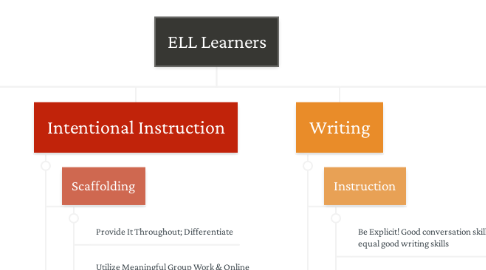
1. Understanding Language
1.1. Context
1.1.1. Prior Life & Educational Experiences
1.1.2. Field, Tenor, & Mode (impacts the way language is used in a particular circumstance)
1.2. A Continuum
1.2.1. Starts concrete, visual and moves abstract
1.2.2. Casual Describing Language to Formal, Written Academic Content-Based
1.3. Challenges
1.3.1. Scaffold and Stretch Learning
1.3.2. Give Rehearsal Time; Strategic Group Work for Peer Support & Scaffolding
2. Create Community
2.1. Embrace Diversity
2.1.1. Student Experts; Multicultural Content & Perspectives
2.1.2. Acknowledge & Celebrate Diversity
2.2. Positive Energy
2.2.1. Open Body Language; Positive Class Talk
2.2.2. Build Student to Teacher, Student to Student, and Teacher to Family Relationships
2.3. Beyond the Classroom
2.3.1. Keep Parents Informed & Involved
2.3.2. Recognize Items/Events of Cultural Significance
3. Reading
3.1. Quality
3.1.1. Linguistically & Culturally Rich
3.1.2. Teach & Use Multiple Reading Strategies
3.2. Active Reading
3.2.1. Reader-to-Text Experience
3.2.2. Reader Roles: decoder, participant, user, analyst)
3.3. Engage
3.3.1. Wide Range of Engaging & Meaningful Materials
3.3.2. Explicit Instruction
4. Intentional Instruction
4.1. Scaffolding
4.1.1. Provide It Throughout; Differentiate
4.1.2. Utilize Meaningful Group Work & Online Resources
4.2. Learning Activities
4.2.1. Clear, Engaging, Fun, Purpose-Driven
4.2.2. Collaborative Group Work- everyone talks, shares, engages
4.3. Plan For Success
4.3.1. "Message Abundancy" and Pacing (slow down)
4.3.2. Before, During, & After Learning Activities- set students up to succeed
5. Writing
5.1. Instruction
5.1.1. Be Explicit! Good conversation skills do not equal good writing skills
5.1.2. Relate it to real-life usage (purpose driven)
5.2. Utilize Multiple Genres
5.2.1. Isolate & teach different types of writing (for each, look at where it occurs within a culture, specific social purpose, organizational structure, specific linguistic features); Scaffold throughout
5.2.2. Digital Literacy is a must
6. Listening
6.1. Reading-Like
6.1.1. Comprehension & Meaning Making
6.1.2. Pathway to Language Development
6.2. Types of Listening
6.2.1. one-way, two-way, multipurpose
6.2.2. topics: everyday interpersonal up to informative/academic
6.3. Instruction
6.3.1. Focus on meaning; integrate listening instruction into regular curriculum; message abundancyh
6.3.2. Learner must do something to demonstrate effective listening; listen for meaning
6.3.3. Active Listening Required
6.3.3.1. Students learn to ask questions and how to effectively listen for different purposes/contexts
6.3.3.2. Meaning-Oriented Activities- require student engagement

